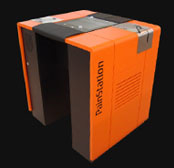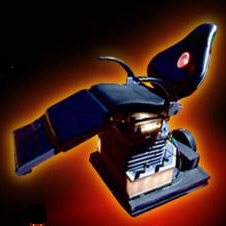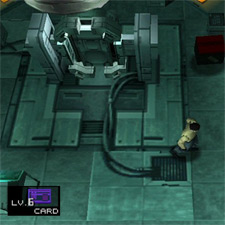MMOrgy: Letting Go: Pain and Play in MMOs
Originally written by qDot for mmorgy.com
In looking around the internet, there seems to be a consensus of people that taking the stance that trust fetishes couldn't be completely actuated through a virtual world, due to the fact that there is no way to transfer physical feelings, or more importantly, pain. While this is a misguided dillution of a deep and interesting socio-sexual environment, at MMOrgy, we aren't here to adjust people's understanding of fetishes. We're here to report the facts on what can be done in virtual worlds.
Pain in games actually has a history, though it is usually one wrapped in art projects and game shows. However, games don't have to be about positive feedback. All a game is, is an environment with goals. The goal could be to cause pleasure, or pain. A controller could just as easily shock you as it does vibrate. So why doesn't it? Well, that's a mainly a matter of litigation, but at the design level, it's also a matter of ethics.
The Current State of Games and Pain: More Relief than Cause
Researching in google for "pain" and "video games" is pretty much a lost cause. If you're looking for reviews of games that are simply painful to play, that'll get you a lot of information. However, there were quite a few articles on how gaming helps relieve pain. VR Pain Control is a project by the University of Washington that uses VR helmets and virutal environments to keep burn victims occupied while their bandages are being changed. In horribly basic terms, immersion in an outside environment takes the brain away from processing pain signals, making the situation more pleasent for the changer and changee. There are also multiple articles from other hospitals outlining how video games are used in childrens hospitals during painful medical tests.
A lot of work is being put into relieving/ignoring pain through video games, but what about causing pain? I took a poll of some people that I trust to know the history of video games, and between all of us, there's really only one group we could think of that created environments caused players pain; the interaction research/art group //////////fur////.
 The Painstation v2.5
The Painstation v2.5
The Painstation is one of their most famous projects. The game is one everyone knows, Pong. To play, users are required to put their hands on metal pads before the game will commense. In each round, a new type of pain will be inflicted up on the loser of the round. Hot, cold, electric shock, and whips are the reward to the losing side. The game doles out punishment that must be accepted in order to keep playing. Adding pain to the game ups the play value, with adreniline and endorphine rushes not usually associated with Pong within at least the last two and a half decades.
 The Chair. Reminds me of the Dream Love Chair.
The Chair. Reminds me of the Dream Love Chair.
What about other types of games involving pain? Mainstream US Media (usually the last place for interesting things to appear, long after they've run their course in Europe) have already picked this up, in the form of ridiculously short-lived gameshows. In 2002, the American ABC TV network had a show called "The Chair". Hosted by tennis great Jon MacEnroe for some weird reason, this show was based purely on pulse control. The player sat in a dentisty type chair and answered questions given by the host. During this time, different "surprises" would happen around them, i.e. loud noises, fireworks, etc... If their pulse went above a certain point, the game would pause, and if they didn't bring their pulse back down within an alloted amount of time, the game was over. No physical pain would ever befall the player (outside of loud noises and an increased heart rate), so this was a totally psychological game, and actually somewhat interesting to watch.
 The Chamber. (I miss American Gladiators, the people were way
more fun there)
The Chamber. (I miss American Gladiators, the people were way
more fun there)
Not to be outdone in the realm of XTREME shows, Fox came out at the exact same time with a show called "The Chamber". This followed the idea of the PainStation, except as a trivia game. Contestants were strapped to a wonderful, only-Fox-could-do-it melding of a St. Andrews Cross and a Lethal Injection Table, put in a metal chamber with a variety of extreme temperature changes happening, and would have questions shouted at them. All sorts of crazy graphs and statistics were put on the screen while the people were in the chamber, and they would usually wail and lament about how horrible it was in the chamber between questions.
It lasted 3 episodes.
So we have relief through immersive virtual environments, pain through fairly simple pick up and play gaming environments, and bondage and domination with (cue Smash TV Annoucer Voice) BIG CASH PRIZES. What about the board game, for those playing at home?
Pain Based Game Feedback and Plot Mechanisms
Starting off simple, there's my specialty, the already covered world of hijacking force feedback signals. We've already proven that once we have access to the signals we can do pretty much anything. However, before we did that, there was the XShox controller. The safety of this is very, very, very questionable, but it proves the point that as much as any game can pleasure, it can also cause pain.
The types of games that could be used for this setup vary between places where they would fit, and others that would require a rather vivid imagination. There are games where the pain is passed onto the player through the avatar on the screen, i.e. fighting games. This is originally what the XShox was invented for. However, repurposing of feedback would require games where the only reason for haptics is pain. Sure, you'll be feeling pain whenever you get hit in a driving game, but unless you really enjoy that idea of getting scrapped along an electric road at 180mph, playing a driving game with this would not be fun.
This brings us to games built specifically for the idea of both positive and negative physical feedback. In order to do this, you'd need some sort of flag that says that a bullet event triggers pain, while a sex event triggers pleasure (because video games are only sex and violence, ya know). The more specialized you get, though, the more hardware is required. I know how much all of us ubergeeks enjoy the idea of "suiting up" before playing a game, but I don't know how well that'd fly with the rest of the world.
The games that I'll focus on for the rest of the article are ones based purely on pain, though. The simple fact that some people enjoy pain cannot be denied, otherwise I wouldn't be writing this right now. So how can you have a game that involves but pain as feedback? How about torture.
 Looking at it makes my hands hurt.
Looking at it makes my hands hurt.
Torture isn't a new idea in games by any means, as anyone that's destroyed their fingers on the god damn torture scene from Metal Gear Solid will remember. Torture has been a part of games for as long as games have had plots that have needed torture. Dungeon Keeper was purely about building a prisons and torture chambers, however much in a tongue in cheek manner it was. None of these games have reflected the pain directly on the user, outside of your hand seazing up from having to pound on buttons.
Design Ideas
Taking away the pretiege of screaming like a little girl when fireworks pop in front of millions of people in order to win $25,000, as the aforementioned game shows provided, when we talk about pain-based video games, we refer to people that are willing to PAY for the luxury of hurting themselves somehow. This affords us all sorts of room to do new and interesting things.
Now, before I start with my ideas, let me state that this is by no means a new idea. Uncle Abdul, master of all that is electrostim, had written on essays on Computerized BDSM (1, 2) years ago. It's usually fair to assume that, when talking about the world of fetishes, that someone has already done something before you, and most likely talked about it on the internet.
Let me first state that I DO NOT RECOMMEND YOU DO WHAT I AM ABOUT TO SAY, as it is stupid, and could ruin you, and more importantly, your computing equipment. The most obvious would be hooking the XShox controller to your computer, and using the SL Interface I built. It's force feedback controlled, therefore it shocks you when a remote person tells it to.
Proof of concept reached. Now really, was that all that difficult?
If we wanted to get innovative, something like the Journey to the Wild Divine interface, only, well, not for relaxation. Same idea as The Chair show. Monitor pulse and reflect positive/negative feedback and relay this to electrostim equipment, vibrators, electronic locking mechanisms, you name it. The body of the participant becomes the control mechanism, with the "dangling carrot" idea driving them to do something possibly painful in order to extract pleasure from the game. Computerized Dom/Dommes, online interaction, there's a ton of ways this could go.
So Why Aren't We Doing This?
Ok, if all this is so easy, why aren't all the wacky people that think online BDSM is so great shocking the crap out of each other?
Simple. They're experimenting with trust fetishes in a safe environment. Physical play is done with multiple people present for a REASON. BDSM is not about the pain. It's about the trust. That's it. There's no hardware limits telling us what we can and can't do at the moment. I could rig up a big ol' internet controlled nut kicker with the parts I have sitting in the room with me right now, but you don't see me doing that. Why? Because, it's irresponsible.
There are many parts of BDSM and other fetishes that people don't find out about until they have proven themselves trustworthy and ready, in a real environment. Otherwise they could hurt themselves or others. The last thing those of us participating in this need is damaged people, and to a lesser extent, damaged image. You shouldn't vac bed by yourself. People do, but they're experienced. Most of you probably aren't even aware of what a vac bed is, and I'm sure you're googling right now.
Go ahead, I'll wait.
Putting remote actuated pain hardware out there for the general public is a bad idea for that exact reason. Just because you've played online doesn't mean you're ready for the next step, especially alone. Pain for pleasure is not something to be experienced alone, it needs supervision, before it becomes pain for /pain/.
Speaking from the perspective of someone who builds these things, that's why you don't see me posting up some of my BDSM projects. You want to know about them, believe me, if you're in the right place at the right time, you'll find out. There's a lot of things publically available on the internet that people will use the wrong way. A metaphor that I use pretty often is that I make guns, but don't talk about the bullets. Now sure, other people do, but that's their perogative. I'm doing what feels right to me.
And Another Thing
So is that it for trust fetishes online?
Hell no.
These fetishes are about trust, something intangible. There may or may not be pain, there may or may not be power trade. Who cares if there is or isn't. This is about the player's trust in something, letting down some barrier they have in their head for something on the other end, be it a person or a piece of code or some amalgamation of both.
If you're strapped to a table and not feeling it, well, then you're just tied up and annoyed. And that's not sexy. Letting down those barriers is by far the most powerful thing anyone could do for anyone else, and in that is where the sexuality lies. We can spend thousands on equipment, but it's never going to replace that feeling.
That's where this comes from. That's why it's popular in virtual worlds, even though we don't have crazy hardware. People can let go over a machine as well as they can in real life, all it takes is a brain.
All that hardware? It's just (slightly salty) icing on the cake.

